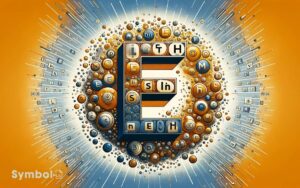Symbol Used to Represent Earth? A Circle With A Cross!
The symbol most commonly used to represent Earth is a circle intersected by a vertical line and a horizontal line, forming a cross beneath it.
This emblem, with its inclusive historical, astronomical, and cultural roots, embodies Earth’s material qualities and its pivotal role in human existence.
Its design suggests balance, stability, and a grounded nature, contrasting with the more ethereal symbols associated with other celestial bodies.
As you explore this symbol’s evolution, from ancient depictions to modern digital icons, you uncover its significance in navigation, environmental movements, and astrology.
Each layer reveals deeper understanding, illustrating humanity’s intrinsic connection to our planet. Unfolding its story offers profound insights into our collective relationship with Earth.

Key Takeaways
Ancient Civilizations Earth Symbols
Throughout history, ancient civilizations have depicted Earth using diverse symbols, each embodying unique cultural perspectives and scientific understandings of the planet.
You’ll find that these symbols often reflect the civilization’s relationship with the Earth, whether it be as a mother, a provider, or a complex system to be studied and understood.
For instance, ancient Egyptians represented Earth as Geb, a deity lying beneath the sky goddess, Nut, depicting the Earth as a foundational, life-sustaining element in their cosmology.
Similarly, in Norse mythology, the Earth was personified as the goddess Jörð, a direct representation of the land itself.
These early symbols demonstrate a profound connection to the Earth, blending mythology with emerging notions of geography and environment.
Each symbol served not only as a religious or mythological figure but also as a metaphor for the civilization’s understanding of the natural world and their place within it.
The Greek Globe and Atlas
In ancient Greek civilization, the conceptualization of Earth underwent a significant transformation with the introduction of the globe and the mythological figure of Atlas, who was doomed to hold the celestial spheres for eternity.
This imagery not only reshaped the Greek understanding of the cosmos but also influenced the symbolic representation of Earth in cultures to follow.
The globe became a pivotal educational tool, enabling scholars to visualize Earth as a spherical entity rather than a flat expanse.
Atlas’ enduring struggle symbolized the weight of celestial knowledge and the human endeavor to comprehend the universe.
This era marked the beginning of scientific cartography, shifting from mythological interpretations to empirical observations of the Earth’s surface.
These developments laid foundational stones for future explorations of Earth’s representation, merging mythology with emerging scientific inquiry.
Medieval Maps and Mappaemundi
Building on the foundation of Greek globes and Atlas’ mythological depiction of the cosmos, medieval maps and mappaemundi offer a vivid illustration of how Earth’s representation evolved in complexity and detail during the Middle Ages.
Mappaemundi, Latin for ‘cloths of the world,’ were large, intricate maps that sought to encapsulate the known world’s geography, theology, and mythology onto a single surface.
Unlike their ancient predecessors, these maps weren’t solely geographical but served as a visual encyclopedia of medieval worldviews.
You’ll notice that mappaemundi often centered Jerusalem, reflecting the era’s religious significance, and depicted known continents with remarkable detail for the time.
This era marks a pivotal shift in cartography, where Earth’s depiction became a blend of scientific observation, religious doctrine, and artistic expression, laying groundwork for future explorations and mapmaking advancements.
The Armillary Sphere Explained
Delving into the domain of astronomical instruments, one can’t overlook the armillary sphere, a complex model that embodies the celestial sphere’s intricate workings.
This ancient device, consisting of a series of concentric rings, serves as a physical representation of the heavens around Earth. It’s not just an emblem of astronomical knowledge but also a tool for teaching and understanding the movements of celestial bodies.
- Construction: Made up of rings, each representing the great circles of the heavens, including the ecliptic and celestial equator.
- Functionality: Enables the demonstration of phenomena such as the precession of the equinoxes and the movement of the planets.
- Historical Significance: Played a crucial role as an instrument in the development of early astronomical theories and navigation techniques.
This scientific marvel, while complex, offers a tangible connection to the cosmos, inviting you to grasp the vastness and beauty of the universe.
Renaissance Depictions of Earth
During the Renaissance, depictions of Earth in art underwent a significant transformation, reflecting the era’s heightened emphasis on realism and scientific inquiry.
Geographic exploration, buoyed by advances in navigation and cartography, directly influenced artists’ portrayals of Earth, leading to more accurate and detailed representations.
The evolution of Earth’s iconography during this period not only marks a shift in artistic techniques but also mirrors broader changes in society’s understanding of the world and its place in the universe.
Earth in Renaissance Art
During the Renaissance, artists meticulously depicted Earth, employing symbolism and naturalistic details to convey its significance and beauty. This era marked a profound shift in the visual representation of the natural world, intertwining art with emerging scientific observations.
Renaissance painters and sculptors infused their works with a deep reverence for Earth, showcasing its diversity and the interconnectedness of all living things.
- Symbolism: Artists used symbols like globes and maps to represent knowledge and exploration, emphasizing Earth’s vastness and mystery.
- Naturalistic Details: Detailed landscapes and botanical accuracy in paintings reflected a growing interest in nature’s intricacies.
- Human Connection: Works often highlighted humanity’s relationship with Earth, suggesting a balance between exploitation and stewardship.
These elements reveal a nuanced understanding of Earth, combining artistic genius with an early scientific curiosity, enriching our perception of the planet.
Geographic Exploration Influences
The Age of Exploration profoundly impacted Renaissance depictions of Earth. Artists integrated newfound geographical knowledge into their works, enriching the era’s artistic tapestry with vivid, accurate portrayals of previously uncharted territories.
This period saw a shift from speculative to empirical representations of the world, driven by navigators’ and explorers’ detailed accounts.
Maps and globes began to reflect the actual contours of continents and oceans, moving away from the allegorical and towards the scientific.
This alteration not only changed the visual representation of Earth but also laid the groundwork for a more interconnected global understanding.
Artists, informed by explorers’ findings, began to depict Earth not as a static entity but as a dynamic, explorable space, marking a significant evolution in humanity’s relationship with its planet.
Iconography Evolution
In Renaissance depictions of Earth, a significant shift occurred as artists began to replace allegorical imagery with detailed, accurate representations informed by the Age of Exploration’s geographical discoveries.
This change in iconography marked a pivotal moment in how humanity visualized its place in the universe, moving from a mythological understanding to a more empirical and scientific approach.
- Accuracy in Cartography: Maps became more precise, incorporating longitudinal and latitudinal lines, reflecting a deeper understanding of Earth’s geography.
- Inclusion of New Lands: Artworks began to feature newly discovered continents, such as the Americas, altering the Eurocentric view of the world.
- Scientific Symbolism: Globes and navigational instruments started to appear alongside Earth, symbolizing the era’s growing emphasis on exploration and knowledge acquisition.
This evolution underscores the profound impact of scientific discovery on artistic expression and societal perceptions of Earth.
The Age of Exploration Icons
Explorers of the Age of Exploration, such as Columbus and Magellan, became enduring icons through their unprecedented voyages that reshaped humanity’s understanding of the world.
Their journeys, marked by risks and discoveries, laid the foundation for modern cartography and fundamentally altered the perception of Earth’s geography.
You’ll find that their contributions went beyond mere exploration; they facilitated a global exchange of goods, cultures, and ideas, knitting the world closer together.
Analyzing the scientific impact, their observations and records provided empirical data that challenged and refined existing geographic theories.
This era’s icons didn’t just explore; they transformed the very fabric of society by connecting disparate cultures and expanding the horizons of the known world, forever altering humanity’s relationship with Earth.
The Earth as a Geometric Shape
You’ve likely encountered the common depiction of Earth as a perfect sphere, but this representation simplifies the planet’s true form.
Scientific analysis reveals that Earth more closely resembles an oblate spheroid, slightly flattened at the poles and bulging at the equator due to its rotation.
This geometric interpretation challenges the simplistic spherical model and invites a deeper understanding of Earth’s shape debate.
Geometric Interpretation
Historically, the Earth has been conceptualized as a sphere due to its large-scale curvature observed by astronauts and through mathematical calculations.
This geometric interpretation isn’t just a simplistic view but an insightful perspective into understanding our planet’s form and gravity.
When you explore into the scientific analysis, several factors reinforce the spherical model:
- Gravitational forces: They pull matter toward the planet’s center, creating a shape that’s closest to a sphere.
- Rotational dynamics: The Earth’s rotation causes it to bulge slightly at the equator, refining the spherical model into an oblate spheroid.
- Geodesy studies: Precise measurements of the Earth’s surface confirm the oblate spheroid shape, enhancing our navigation and satellite communication systems.
This analytical approach underscores the importance of geometric interpretation in comprehending the Earth’s shape and its implications on various scientific fields.
Earths Shape Debate
Why does the debate over Earth’s shape, considering it as a geometric entity, continue to spark interest among scientists and laypeople alike?
The discourse thrives because Earth’s shape isn’t a perfect sphere. It’s an oblate spheroid, flattened at the poles and bulging at the equator due to its rotation.
This deviation prompts intricate discussions among geoscientists, who analyze variations in gravitational forces, density, and topography to understand Earth’s precise shape.
You’ll find that satellite data and sea level measurements offer critical insights, yet no single model captures Earth’s complexity entirely.
This ongoing analysis not only advances our understanding of Earth but also enhances satellite navigation systems and climate models, underscoring the importance of this seemingly esoteric debate in practical applications.
The Blue Marble Image Impact
The iconic ‘Blue Marble’ photograph, taken by the Apollo 17 crew in 1972, profoundly influenced public perception of Earth, fostering a newfound global consciousness and environmental awareness.
This image, showcasing Earth’s vulnerability and isolation in the vast expanse of space, served as a catalyst for the burgeoning environmental movement. It underscored the fragility of our planet, highlighting the importance of stewardship and sustainable living.
- Visual Impact: It provided a powerful visual representation of Earth as a cohesive, interconnected system.
- Environmental Consciousness: Sparked an intensified focus on environmental policies and conservation efforts.
- Global Unity: Fostered a sense of global unity and shared responsibility towards the only home humanity has.
Analyzing the ‘Blue Marble’ image’s impact reveals its critical role in shaping contemporary environmental discourse and global awareness.
Modern Digital Earth Icons
You observe the evolution of icon design as it mirrors advancements in digital technology, highlighting a shift towards more abstract yet universally recognizable representations of Earth.
The incorporation of these icons into global navigation systems not only facilitates spatial orientation but also embeds a layer of symbolic significance, underscoring the interconnectedness of global communities.
Moreover, the proliferation of environmental awareness graphics serves as a visual reminder of Earth’s vulnerability, urging a collective stewardship of its resources.
Icon Design Evolution
Modern digital earth icons have undergone a significant transformation, evolving from simple, static images to dynamic, interactive representations that reflect the planet’s complexity and diversity.
This progression isn’t just aesthetic but deeply rooted in our enhanced understanding of the Earth and technological advancements. The icons now serve not only as symbols but as tools for education and navigation, embodying a multitude of data in a compact, visual form.
- Increased Resolution: Modern icons feature higher resolution, allowing for detailed representations of continents, oceans, and natural phenomena.
- Real-time Data Integration: They can display real-time environmental changes, such as weather patterns and natural disasters.
- Interactivity: Enhanced interactivity supports user engagement, offering zoom, rotation, and information layers that reveal deeper insights about specific regions.
These developments make modern earth icons not just symbols, but gateways to understanding our planet’s intricate systems.
Global Navigation Symbols
Building on the advancements in icon design, global navigation symbols now incorporate sophisticated digital earth icons, reflecting an unprecedented level of detail and functionality for navigational purposes.
These symbols, deeply rooted in geographic information systems (GIS), leverage high-resolution satellite imagery and vector graphics to offer users an intuitive understanding of terrestrial locations.
When you interact with these icons on your digital device, you’re engaging with a complex amalgamation of data layers that represent not just the physical topography of Earth but also infrastructural and geopolitical boundaries.
The precision of these symbols is critical in applications ranging from aviation to maritime navigation, ensuring that users can pinpoint exact locations with minimal error margins.
This scientific approach to iconography enhances user experience by providing reliable, at-a-glance information for global navigation tasks.
Environmental Awareness Graphics
Harnessing the power of digital technology, environmental awareness graphics now offer an intricate depiction of Earth’s ecological changes, directly engaging users with the planet’s environmental health.
These visuals serve as powerful tools, translating complex environmental data into accessible and compelling narratives.
They’re not just static images; they’re dynamic, interactive representations that allow users to witness the consequences of human actions on the planet in real time.
- Data Visualization: Leveraging big data to map out environmental degradation, pollution levels, and deforestation in vivid detail.
- Interactive Simulations: Enabling users to explore various scenarios and their potential impacts on Earth’s future.
- Real-Time Tracking: Offering the ability to monitor natural phenomena like melting ice caps or rising sea levels as they happen, fostering a deeper connection and understanding of our planet’s delicate balance.
Environmental Movement Emblems
Various symbols have emerged to represent the environmental movement, each encapsulating a unique facet of the global effort to promote sustainability and ecological balance. You’ll find that these emblems serve as visual shorthand for complex ecological concepts.
For instance, the green circle, often embodying the planet’s finite resources, symbolizes the notion of global unity in the pursuit of environmental preservation.
Alternatively, the recycling symbol, a triumvirate of arrows looping into a triangle, underscores the continuous cycle of reuse and sustainability.
These symbols aren’t merely artistic; they’re steeped in scientific principles, advocating for a harmonious coexistence with our ecosystem.
They encourage you to ponder the intricate web of life and the human role within it, highlighting the critical need for conservation and thoughtful engagement with our planet’s resources.
Earth Day Symbols and Logos
Among the most recognizable Earth Day symbols, the globe encircled by olive branches epitomizes the global call for peace and environmental protection, reflecting a deeply scientific understanding of ecological interdependence.
This symbolism isn’t just aesthetic; it’s rooted in a complex interplay of biological, ecological, and sociopolitical factors that underscore the urgency of Earth’s conservation efforts.
- The Globe: Represents the entirety of Earth, highlighting the interconnectedness of all life forms and ecosystems.
- Olive Branches: Symbolize peace, suggesting that environmental conservation is integral to achieving global harmony.
- Colors: Earth Day logos often feature green, symbolizing life, nature, and renewal, alongside blue for water, emphasizing the planet’s vulnerability and the need for sustainable management of its resources.
Understanding these symbols deepens your appreciation for Earth Day’s mission, encouraging a more thoughtful engagement with environmental activism.
Astrological Symbol for Earth
Shifting focus to the domain of astrology, the Earth symbol offers a significant lens through which we can explore our planet’s place in the cosmos and our connections to it.
This symbol, represented by a circle with a cross inside, encapsulates Earth’s material qualities and our grounded experience in the physical world. This emblem serves as a reminder of the interconnectedness between humanity and the natural elements that sustain us. The origin of the cross symbol within the circle is often linked to ancient traditions, where it represented the harmonious balance between the cardinal directions and the cycles of life. It invites reflection on how these timeless concepts influence our modern perception of existence.
It’s not merely an icon; it’s a profound representation of Earth’s centrality in human life, highlighting our inherent link to this terrestrial sphere.
Astrologically, this symbol underscores the balance and stability that Earth provides, contrasting with the volatile energies of other celestial bodies.
It invites a scientific reflection on how astrology conceptualizes Earth’s influence, not just as a physical entity, but as an essential component in a larger cosmic narrative.
This perspective enriches our understanding of Earth’s role, reminding us of our deep, intrinsic connection to the very planet we inhabit.
Future Representations of Earth
As we project into the future, the representation of Earth in cultural and scientific narratives may evolve, reflecting our changing understanding and relationship with our planet.
- Integration of Digital and Augmented Realities: Future Earth symbols might incorporate elements from digital and augmented realities, offering a more dynamic and interactive representation of Earth’s diverse ecosystems and human cultures.
- Influence of Space Exploration: As space exploration advances, symbols may incorporate views of Earth from space, emphasizing the planet’s fragility and interconnectedness within the larger cosmos.
- Incorporation of Global Challenges: Future representations could highlight pressing global challenges, such as climate change and biodiversity loss, urging a collective responsibility towards sustainable living and planetary stewardship.
These evolving symbols will likely serve not just as representations but as calls to action, urging us towards a more sustainable and interconnected global society.
Conclusion
In your journey through the ages, you’ve seen Earth’s identity shape-shift like a chameleon against the vast canvas of human culture.
From ancient glyphs to modern logos, each symbol serves as a microscopic lens, focusing the infinite complexity of our planet into a form graspable by the human mind.
As you stand at the threshold of the future, remember, these symbols aren’t just artistic expressions but scientific beacons, guiding our understanding and respect for this celestial orb we call home.





